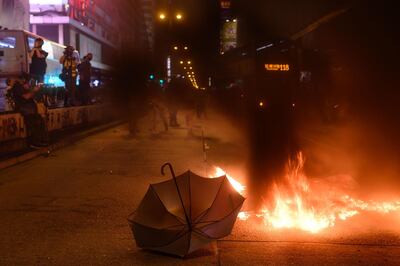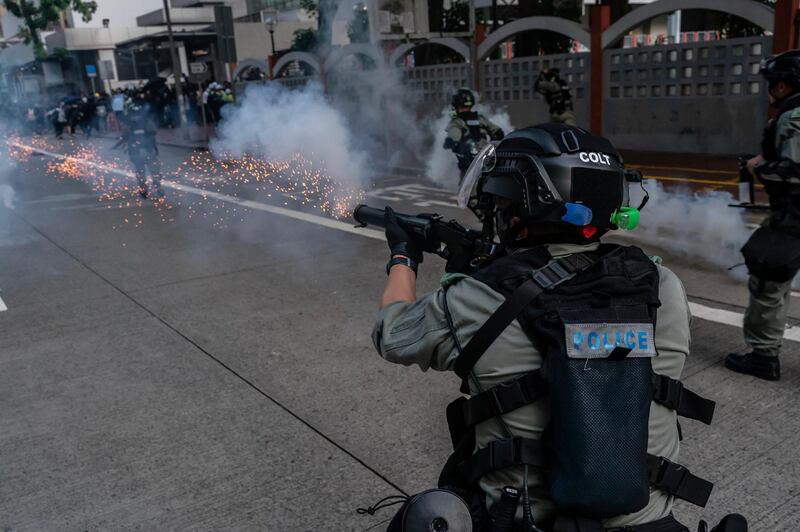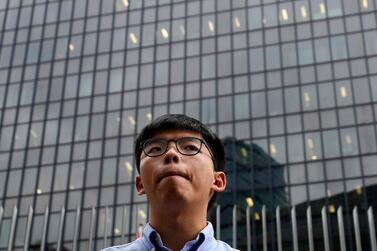Hong Kong police fired tear gas and water cannon on Saturday as thousands of protesters defied authorities in another unsanctioned march after Beijing vowed to tighten control over the restless city.
Commercial districts on the main island turned into a battleground as crowds of black-clad protesters, many wearing face masks despite a recent ban, clashed for hours with riot police.
Hardcore protesters hurled bricks and petrol bombs and vandalised several subway stations and businesses perceived to be pro-China – including the office of China's state-run Xinhua news agency, which had its windows smashed.
Police responded with sustained volleys of tear gas, scattering protesters with water cannon trucks and making dozens of arrests.
After one clash an AFP reporter saw about 100 people being taken away in three coaches.
Among those caught up in the tear-gas clouds were rugby fans who had gathered in bars in Wanchai district to watch the World Cup final.
Hours later, revellers in a nightclub district had a similar experience as partygoers scrambled for cover and bars shut their windows.
A medical volunteer in the crowd was burnt when a tear-gas canister struck him on his back, footage showed.
By evening, the clashes had moved across the harbour to Mong Kok and Tsim Sha Tsui, areas where there have been regular skirmishes in recent months.

Xinhua condemned the "barbaric acts" of the protesters who attacked their office.
The latest unrest came after China gave a warning on Friday that it would not tolerate any challenge to Hong Kong's governing system and planned to increase patriotic education in the city, which has seen 22 consecutive weekends of youth-led protests.
Hong Kong has been upended by the huge, often violent protests which have battered the financial hub's reputation for stability and helped plunge the city into recession.
Beijing has shown no willingness to meet protester demands for greater democratic freedoms and police accountability, and activists show no sign of leaving the streets.
"The government and the police have been ignoring and suppressing the people's demands so we need to continue the movement to show them we still want what we are asking for," 18-year-old protester Gordon Tsoi, who was not wearing a mask, told AFP as he marched.
"The entire government is being controlled by the central government now, so we have to come out to protect the freedoms we deserve," added another 17-year-old protester who declined to give his name.
Police had rejected an application for an afternoon march, citing safety fears. But, as often in the past, protesters simply defied the ban with thousands turning up before the clashes began.
After months of unrest, ideological polarisation has erupted with protesters taunting police and officers returning the disdain.
In a video from Saturday, officers could be heard shouting that protesters were "cockroaches" and "sub-human". Protesters routinely call police "triads".
Among those calling for people to come out on Saturday was Joshua Wong, one of the city's most prominent activists who was barred earlier this week from standing in coming local elections.
"Exercising freedom of assembly has become increasingly difficult as police in HK holds tighter grip in recent months. Yet we're not giving up our constitutional rights," he wrote on Twitter.
Chinese state media often brands Mr Wong a "separatist" and a "traitor" because he advocates greater autonomy for Hong Kong.
He denies seeking independence and says he campaigns for the democratic freedoms and autonomy Beijing promised Hong Kong for 50 years after the 1997 handover by Britain.
Other people who call for greater autonomy have been allowed to stand in the elections later this month.
Beijing runs Hong Kong under a "one country, two systems" model that grants the city freedoms unheard of on the mainland.
But many activists fear those freedoms are being eroded.
This summer's first protests in which millions marched were sparked by a now-abandoned attempt to allow extraditions to the mainland.
But as Beijing took a hard line, the movement snowballed.
Protesters are demanding an inquiry into the police, an amnesty for those arrested and free elections.
Over the months, protests have become increasingly violent, with smaller groups of hardcore activists throwing petrol bombs and bricks as well as vandalising pro-China businesses.
Police have responded with ever-increasing arrests, tear gas and rubber-bullet volleys while crowd beatings of people on both sides of the ideological divide have become commonplace.






